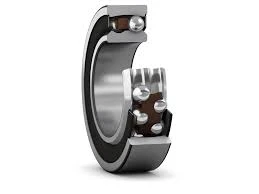
ធ្នូ . 06, 2024 21:01 Back to list
ceramic thrust bearing
The Advancements and Applications of Ceramic Thrust Bearings
In the realm of mechanical engineering, the quest for materials that can withstand extreme conditions while providing superior performance has led to the development of various types of bearings. Among them, ceramic thrust bearings have emerged as a groundbreaking solution, particularly suited for applications where high temperatures, corrosive environments, and heavy loads are prevalent. This article delves into the properties, advantages, and applications of ceramic thrust bearings, highlighting their significance in modern engineering.
Understanding Ceramic Thrust Bearings
Ceramic thrust bearings are engineered components designed to support axial loads, allowing rotational motion while minimizing friction between moving parts. Unlike traditional metal bearings, ceramic bearings are made from advanced materials such as silicon nitride or zirconium dioxide, which offer exceptional properties. These materials are renowned for their hardness, wear resistance, and low thermal expansion. As a result, ceramic thrust bearings can operate effectively at elevated temperatures, up to 1,000 degrees Celsius, making them ideal for specialized applications.
Advantages of Ceramic Thrust Bearings
1. High Temperature Resistance One of the primary advantages of ceramic thrust bearings is their ability to perform at high temperatures without losing structural integrity. In industries such as aerospace and energy production, where machinery often operates under extreme thermal conditions, the use of ceramic bearings ensures reliability and longevity.
2. Corrosion and Wear Resistance Ceramics are inherently resistant to chemical degradation and wear. This characteristic makes ceramic thrust bearings suitable for environments exposed to corrosive substances, such as petrochemical plants and marine applications. The longevity of these bearings minimizes maintenance costs and increases the operational lifespan of machinery.
3. Lightweight Ceramic materials are significantly lighter than metals, which contributes to the overall weight reduction of machinery. In applications such as automotive and aerospace engineering, the reduction in weight can lead to increased fuel efficiency and improved performance.
4. Low Friction The surface properties of ceramics allow for reduced friction between the bearing surfaces, leading to smoother operation and enhanced energy efficiency. This low friction is particularly beneficial in high-speed applications, improving overall performance and reducing wear on components.
ceramic thrust bearing

Applications of Ceramic Thrust Bearings
Ceramic thrust bearings have found their place in various industries due to their unique properties. Some notable applications include
- Aerospace In aircraft engines, ceramic thrust bearings can withstand high temperatures and pressures, contributing to the safety and efficiency of flight operations. - Automotive High-performance vehicles utilize ceramic bearings in turbochargers and electric motors to enhance power output while maintaining reliability.
- Marine The corrosion resistance of ceramic thrust bearings makes them invaluable in marine applications, where exposure to saltwater can degrade metal components.
- Industrial Machinery In manufacturing processes involving high speeds and loads, the application of ceramic thrust bearings helps in achieving better performance and longer service life.
- Medical Devices The biocompatibility and cleanliness of ceramics make them suitable for use in medical equipment, where precision and reliability are critical.
Conclusion
The evolution of ceramic thrust bearings represents a significant advancement in bearing technology. Their unique properties offer solutions to many challenges faced in various industries, from aerospace to medical devices. As engineering continues to advance, the role of ceramic thrust bearings is expected to expand, fostering innovation and enhancing the performance of modern machinery. As businesses seek to optimize operations and minimize costs, adopting ceramic thrust bearings can be a critical step toward achieving those goals.
Latest news
-
Premium Deep Groove Ball Bearings | High Speed & Reliability
NewsAug.29,2025
-
Durable Scaffolding Clamps - Secure & Reliable Tube Connectors
NewsAug.28,2025
-
Common Failures in Thrust Ball Bearings and Solutions
NewsAug.22,2025
-
How Tapered Roller Bearings Can Take Shock Loads
NewsAug.22,2025
-
Angular Bearings in High-Precision Spindles
NewsAug.22,2025
-
The Impact of Misalignment on Cylindrical Roller Bearing Performance
NewsAug.22,2025
